Hi 👋
I designed and 3-D printed experimental pod speakers. I’ve tried to keep the cost down as much as possible, which is important me. I chose the two following drivers for my tweeter and midbass enclosures:
Pioneer TS-M800Pro
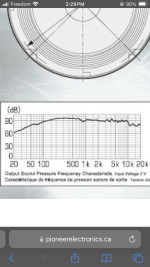
Dayton Audio ND25FA-4
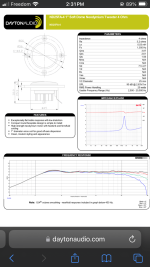
I chose a cheap crossover from Amazon is there any problem to use it or better to buy a different one?
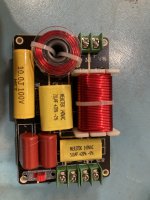
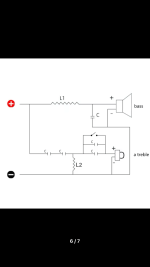
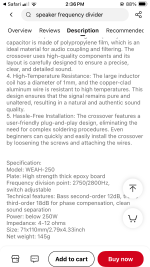
Here is my speaker design concept:

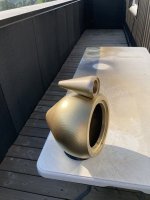
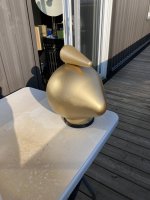
Optional sub pod:
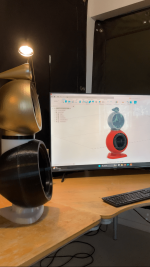
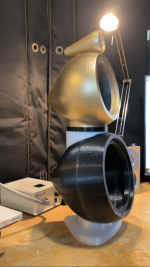
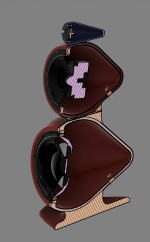
The color is not finalized. You can say it’s ugly too 😆
I designed and 3-D printed experimental pod speakers. I’ve tried to keep the cost down as much as possible, which is important me. I chose the two following drivers for my tweeter and midbass enclosures:
Pioneer TS-M800Pro

Dayton Audio ND25FA-4

I chose a cheap crossover from Amazon is there any problem to use it or better to buy a different one?



Here is my speaker design concept:



Optional sub pod:



The color is not finalized. You can say it’s ugly too 😆
Attachments
Last edited:
It's a universal crossover board which is said to be suitable for 4 to 12 ohm drivers.
That means we can't be certain that it will provide a suitable crossover frequency for your two 4 ohm drivers.
The crossover point should be at least an octave above the tweeter's frequency of resonance which, according to its impedance curve, occurs at around 1,500 Hz.
Without measurements, this would be a case of 'suck it and see'. If the tweeter sounds harsh and distorted that would tell you that the crossover frequency is not high enough and that tweeter damage will ensue. In that case, a crossover should be designed that is dedicated to these particular drivers.
That means we can't be certain that it will provide a suitable crossover frequency for your two 4 ohm drivers.
The crossover point should be at least an octave above the tweeter's frequency of resonance which, according to its impedance curve, occurs at around 1,500 Hz.
Without measurements, this would be a case of 'suck it and see'. If the tweeter sounds harsh and distorted that would tell you that the crossover frequency is not high enough and that tweeter damage will ensue. In that case, a crossover should be designed that is dedicated to these particular drivers.
You can certainly try that crossover. The nice thing about Amazon is you can return it. Have a look at the 4 channel amplifier boards with DSP crossovers built in at partsexpress.com If you are comfortable with using a PC, you can create perfect crossovers with the software and one of these boards for a pair of 2 way speakers.

P.S. Looking at the circuit, I would not switch out (short out) the capacitors that follow L2 as that will make the tweeter roll off less sharply and allow it to pass more, possibly damaging, energy below its crossover point.
It's a good idea but I have my own amplifiers that I want to use some of them have onboard electronic crossovers. My main problem is I forgot to fillet an external header on the tweeter for speaker terminals so I could keep it as isolated 3 way design. I am stuck at this point to use an electronic crossover and need to integrate a 2 way passive crossover to be able to overcome that problem. I don't know much about crossover design for these drivers and how to choose the crossover points correctly. There is a variety of passive two way crossovers that vary with 2.5, 3, 4 and 5 KHz points so I really don't know which to choose. The sub enclosure is an optional fitting and relies on electronic variable LPF from an amp I already have for tuning. I saved that part for last because the system is modular you can "stack on" to the sub if you want to use it -- its a desktop speaker pod design or one that sits on a speaker stand that is around 2-3 feet high. Any input or suggestions is appreciated.You can certainly try that crossover. The nice thing about Amazon is you can return it. Have a look at the 4 channel amplifier boards with DSP crossovers built in at partsexpress.com If you are comfortable with using a PC, you can create perfect crossovers with the software and one of these boards for a pair of 2 way speakers. View attachment 1355214
Last edited:
May I take it from the above that you have not yet purchased the crossover board that you illustrated?
In all probability you could do better by building your own crossover, even if it only based on a simple crossover calculator.

Looking at the frequency responses of your 4 ohm drivers and the resonance frequency of the tweeter, I would consider a crossover frequency of 4,000 Hz to be suitable when using the above 2nd order (12 dB/octave) crossover circuit.
Each capacitor is a 6.8 uF polypropylene type and each inductor is a 0.22 mH air core type. These are readily available standard values.
Not optimum by any means (the crossover designers will be tearing their hair out!), but safe for your tweeter.
Looking at the frequency responses of your 4 ohm drivers and the resonance frequency of the tweeter, I would consider a crossover frequency of 4,000 Hz to be suitable when using the above 2nd order (12 dB/octave) crossover circuit.
Each capacitor is a 6.8 uF polypropylene type and each inductor is a 0.22 mH air core type. These are readily available standard values.
Not optimum by any means (the crossover designers will be tearing their hair out!), but safe for your tweeter.
As per Galu's comments, but suggest buying a few cheap resistors of different values to tame the tweeter if it sounds to bright: say 2, 4 and 6 ohms.
Geoff
Geoff
If you want to nudge the crossover point up to 5,000 Hz to be really kind to the tweeter, use 5.6 uF and 0.18 mH.
I note, Geoff, that the woofer has a sensitivity of 96 dB/W/m while the tweeter is 90 dB/2.83 V/m. It is unlikely that the tweeter will require attenuation.
I note, Geoff, that the woofer has a sensitivity of 96 dB/W/m while the tweeter is 90 dB/2.83 V/m. It is unlikely that the tweeter will require attenuation.
@myfirstamplifier
I can foresee a problem regarding your choice of tweeter.
The Pro-Series 4 ohm mid woofer has a very high sensitivity of 96 dB/W/m, meaning it will play loud for just one watt of amplifier power.
This mid woofer is intended to be partnered with a 4 ohm Pro-Series bullet tweeter with a higher sensitivity of, say, 100 dB/W/m.
The 4 ohm dome tweeter you have chosen has a sensitivity of 90 dB/2.83V/m which equates to only 87 dB/W/m, meaning you have a substantial sensitivity mismatch.
We can attenuate a 100 dB/W/m tweeter to match a 96 dB/W/m mid woofer. However (because it handles around 10x more power than the tweeter) we cannot safely attenuate a 96 dB/W/m mid woofer that is too sensitive for a 87 dB/W/m tweeter.
I can foresee a problem regarding your choice of tweeter.
The Pro-Series 4 ohm mid woofer has a very high sensitivity of 96 dB/W/m, meaning it will play loud for just one watt of amplifier power.
This mid woofer is intended to be partnered with a 4 ohm Pro-Series bullet tweeter with a higher sensitivity of, say, 100 dB/W/m.
The 4 ohm dome tweeter you have chosen has a sensitivity of 90 dB/2.83V/m which equates to only 87 dB/W/m, meaning you have a substantial sensitivity mismatch.
We can attenuate a 100 dB/W/m tweeter to match a 96 dB/W/m mid woofer. However (because it handles around 10x more power than the tweeter) we cannot safely attenuate a 96 dB/W/m mid woofer that is too sensitive for a 87 dB/W/m tweeter.
I thought you were implying that it's spot on, going by typical baffle step considerations.the woofer has a sensitivity of 96 dB/W/m while the tweeter is 90 dB/2.83 V/m. It is unlikely that the tweeter will require attenuation.
They may actually prevail.
Clearly though we have a unique baffle arrangement here and I guess it's hard to say without putting in some work.. but no doubt there will be some half space directivity in the mix.
The Pro-Series 4 ohm mid woofer has a very high sensitivity of 96 dB/W/m, meaning it will play loud for just one watt of amplifier power.
The 96dB are measured with a infinite baffle. The planned enclosure got the smallest possible baffle. You can expect to lose 6-7dB by that because the 96dB are only reached between 300 and 700 Hz and at 100 Hz it's already at just 85dB (see picture #1 in infinite baffle, one divider equals 5dB!). That means, after subtracting the baffle step from that, you will end up at roughly 78dB.
This mid woofer is intended to be partnered with a 4 ohm Pro-Series bullet tweeter with a higher sensitivity of, say, 100 dB/W/m.
The 4 ohm dome tweeter you have chosen has a sensitivity of 90 dB/2.83V/m which equates to only 87 dB/W/m, meaning you have a substantial sensitivity mismatch.
Like I already said, it doesn't matter. Since the enclosures got the smallest possible baffle and the baffle shape is the shape with the maximal possible baffle step (round), it will be a real challenge to develop a passive crossover. To use a DSP would be an immense help and at the same time that would remove the restrictions regarding sensitivity nearly completely.
I assume the subwoofer enclosure might be too small.
Hi Gents - Thanks for all the info. It is great to find people that are more knowledgeable than myself.
I got the idea for this design reading Henry Olsens paper on "Direct Radiator Speakers" and sort of morphed the spherical into my own design with hopes I could retain some of the flatness he found:
Direct Radiator Loudspeakers - AES 1951
I tried to keep the midbass and sub enclosure volumes around 1 Cubic FT. This was recommended volume for at least the sub in the Pioneer manual FWIW. I can try different Pioneer drivers and maybe that ultra cheap fullrange to compare the one Nelson has played with if I recall it is this one:
https://www.parts-express.com/GRS-8...VYc2XTS3aq2wazLATZvS8AP6MhNFMCFO5c0lYfF94KxLz
Other 8" speakers may drop in and fit as I gave a little space for that. If they are the same size as the M800 series then they will fit very snug.
I'll try and get them wired up this weekend enough to test.
I got the idea for this design reading Henry Olsens paper on "Direct Radiator Speakers" and sort of morphed the spherical into my own design with hopes I could retain some of the flatness he found:
Direct Radiator Loudspeakers - AES 1951
I tried to keep the midbass and sub enclosure volumes around 1 Cubic FT. This was recommended volume for at least the sub in the Pioneer manual FWIW. I can try different Pioneer drivers and maybe that ultra cheap fullrange to compare the one Nelson has played with if I recall it is this one:
https://www.parts-express.com/GRS-8...VYc2XTS3aq2wazLATZvS8AP6MhNFMCFO5c0lYfF94KxLz
Other 8" speakers may drop in and fit as I gave a little space for that. If they are the same size as the M800 series then they will fit very snug.
I'll try and get them wired up this weekend enough to test.
I've made a mistake, I subtracted the baffle step twice, sorry. It's 88-89dB but without EQing or losses by the coils, so probably 86-87dB.
You're welcome.Thank you both for the explanations.
When I say I find it difficult, I'm really saying I don't have enough information. These enclosures are an unknown quantity. As OP says, they are experimental.
Ideally I'd ask for polar plots of each pod, however if measurements are not an option then I'd consider working out where each goes from wide dispersion to beaming, and try to avoid regions of great change.
With a non optimal crossover choice, a speaker might not sound right across different regions of the spectrum even when the response is flat. Purely for example, it may not be easy to get the treble loud enough and quiet enough at the same time. It may seem to cut in heavy with insufficient lower treble support.
I have a question about gathering the plots and objective measurements. I have a Soundblaster ZXR which uses Burr Brown ADC/ADC.
It has a input for 1/4" microphone and 1/8" microphone. What kind of microphone is best to use to make the measurements? I figure I would start with trying out REW or is there a better tool for this?
| Digital-to-Analog Convertor (DAC) - Main board |
|
| Analog-to-Digital Convertor (ADC) - DBPro board |
|
It has a input for 1/4" microphone and 1/8" microphone. What kind of microphone is best to use to make the measurements? I figure I would start with trying out REW or is there a better tool for this?
I presume it's the input sockets that are 1/4" and 1/8" and not the microphone?
A measurement microphone will often require phantom power. In other words, a preamp. Some sound cards have the capability on their own. The cables you use will become apparent when you set this up.
A measurement microphone will often require phantom power. In other words, a preamp. Some sound cards have the capability on their own. The cables you use will become apparent when you set this up.
Some sound cards have the capability on their own. The cables you use will become apparent when you set this up.
There is a good, cheap mic that doesn't need phantom power, it got batteries for power. The big advantage is that even if the sound card has phantom power, it is a different voltage for each card and the voltage so the preamp in the mic will deliver different levels - that can't happen with the Superlux ECM 888 B. There are other solutions for this problem but this is the easiest one.
- Home
- Loudspeakers
- Multi-Way
- Help with crossover choice for my 2 way pod speakers 🔊

